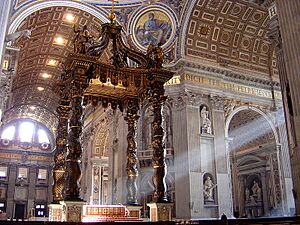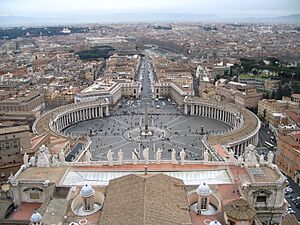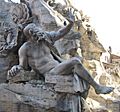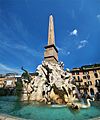Gian Lorenzo Bernini facts for kids
Quick facts for kids
Giovanni Lorenzo Bernini
|
|
|---|---|
 |
|
| Born | 1598 |
| Died | 1655 |
| Other names | Gianlorenzo Bernini |
Giovanni Lorenzo Bernini (1598-1655), also known as Gianlorenzo Bernini, was a super famous artist from Italy. He lived during a time called the Baroque period. Bernini was amazing at both sculpture (making statues) and architecture (designing buildings).
From 1627, he worked for important leaders of the Catholic Church, like Pope Urban VIII and Pope Alexander VII. He spent many years at St. Peter's Basilica in Rome. There, he designed the famous big square (called a piazza) in front of the church. He also created many beautiful things inside the basilica.
Contents
Early Life and Inspiration
Bernini was born in Naples, Italy. His father, Pietro Bernini, was also a well-known sculptor. When Gianlorenzo was about seven years old, his family moved to Rome.
Living in Rome, young Bernini saw the incredible artworks of many famous artists. He saw the amazing fresco paintings on the ceiling of the Sistine Chapel by Michelangelo. These paintings showed stories from the Bible, like the Creation. He also saw the huge dome of St. Peter's Basilica, which Michelangelo designed.
Bernini also knew Annibale Carracci, an artist who painted scenes on ceilings for the pope. These scenes often told stories from Ancient Rome. Carracci took Bernini inside St. Peter's Basilica. Bernini was so moved that he decided he wanted to create something beautiful to honor Saint Peter.
Another artist who inspired Bernini was Caravaggio. Caravaggio's paintings were very different. They were often dark and dramatic, but they looked incredibly real. The people in his paintings seemed to breathe and feel emotions. Bernini learned a lot from seeing these different styles.
Bernini's Amazing Artworks
By the time he was 20, Bernini was a skilled sculptor. He learned how to carve marble from his father. But he also learned how to make his statues tell stories, like Michelangelo and Carracci. And he made them seem alive, like Caravaggio's figures.
An important leader in the Catholic Church, Cardinal Scipione Borghese, saw Bernini's work. The cardinal became his patron, meaning he paid Bernini to create many beautiful sculptures. Soon, the cardinal's uncle, Pope Urban VIII, heard about Bernini. The Pope asked Bernini to work for him at St. Peter's Basilica. Bernini spent 40 years of his life there, only leaving for a trip to France and short visits to other cities.
Sculptures That Tell Stories
Most sculptures back then showed just one person. But Bernini made groups of figures that told exciting stories. He was inspired by Michelangelo's "Pieta," which shows the Virgin Mary grieving over Jesus' body.
One of Bernini's famous groups is from Roman Mythology. It shows the god Apollo chasing a beautiful wood nymph (a type of fairy). Her father used magic to turn her into a tree. Bernini carved the exact moment her toes become roots, her legs turn into a trunk, and leaves sprout from her hands and hair. She looks horrified. It was amazing how Bernini made stone look like soft flesh, rough wood, and delicate leaves.
Bernini's most famous sculpture is St. Theresa in Ecstasy. It tells the story of a saint who had a vision of an angel. The vision was so beautiful that she fainted. Bernini sculpted St. Theresa lying on a cloud with a laughing angel in front of her. Their clothes seem to float, making it hard to believe it's all carved stone. Bernini also designed the chapel around it, making it look like a stage. He even carved people watching the scene from a balcony.
Rome has many squares with beautiful fountains. Pope Alexander VII wanted to make the city even more beautiful. Bernini was asked to create the "Fountain of the Rivers" in Piazza Navona. This fountain has four figures that represent four rivers. Bernini carved one figure looking at the nearby church of St. Agnes (built by another architect, Borromini) and throwing his hands up in shock. This was Bernini's joke, and it's still there today!
Bernini's Work at St. Peter's Basilica
The Grand Baldacchino
Bernini's first big project at St. Peter's was designing the "baldacchino." This is like a giant bronze canopy or tent over the main altar. It's 30 meters (98 feet) tall and is probably the largest bronze artwork in the world. It stands under Michelangelo's huge dome. The baldacchino has four giant twisted bronze columns. They are decorated with olive leaves and bees, which were symbols of Pope Urban VIII. Bernini even added the faces of the Pope's niece and her baby boy to the columns.
Statues in the Pillars
The basilica's dome is held up by four enormous stone pillars. Bernini had a clever idea for these pillars. He had four hollow spaces, called "niches," carved into them. Here, four huge statues could stand. Some people worried the dome would fall, but it didn't!
The basilica has some very old and precious items called relics. These include a piece of the True Cross of Jesus, a veil that a woman used to wipe Jesus' face, the spear that pierced Jesus' side, and the bones of St. Andrew. Bernini planned to make four marble statues of the holy people connected to these relics: St. Helena (who found the cross), St. Longinus (the soldier with the spear), St. Veronica (who wiped Jesus' face), and St. Andrew. Although Bernini designed them, only the statue of St. Longinus was carved by him. The others were made by different sculptors.
The Chair of St. Peter
Bernini's next big project was to create a special bronze throne. This throne holds an ancient wooden and ivory chair that had been in the basilica for over 500 years. It's called the Cattedra Petri or "throne of St. Peter." The bronze throne, with the old wooden one inside, is held high at the end of the basilica. Four important saints, known as "Doctors of the Church," support it. These saints were great writers and teachers.
Above the chair is a special window made of thin, see-through stone called alabaster. In the middle of the window is a dove, representing the Holy Spirit. Golden clouds and angels surround it, with rays of light spreading into the basilica. Bernini designed this to look like a window into Heaven. It was a huge celebration when the chair was put in place on January 16, 1666.
St. Peter's Square
The large open area in front of St. Peter's Basilica is called the Piazza di San Pietro (St. Peter's Place). Bernini designed this famous square between 1656 and 1667. It was a challenging job because he had several things to consider.
First, some people thought the front of St. Peter's looked too wide. Bernini wanted to make it appear narrower. Second, there was an ancient Egyptian obelisk (a tall, four-sided stone pillar) in the old square. This obelisk was 40 meters (131 feet) high and very difficult to move. Bernini needed to make it the center of his new design, even though it wasn't exactly in the right spot. Third, there was already a fountain on one side of the obelisk, so Bernini had to build another one to match it, making the design balanced.
Bernini solved these problems by creating two main areas in the square. The first area, right in front of the basilica, is almost square. Its sloping sides cleverly make the building look taller. The second part of the piazza is oval-shaped. It has the obelisk in the center, with the two matching fountains on either side.
The entire piazza is surrounded by a colonnade (a covered walkway) supported by tall columns. All around the colonnade are large statues of saints. These seem to look down on the thousands of visitors who come to the square every day. The colonnade forms two great arcs that look like loving arms, welcoming people to the Basilica.
A famous architectural historian, Sir Banister Fletcher, said that no other city in the world has such a wonderful view for visitors to its main church. He believed that only Bernini could have imagined such a grand design. He called it the greatest entrance to the greatest Christian church in the world.
The Chapel of the Sacrament
Bernini's last work for St. Peter's was decorating the Chapel of the Sacrament in 1676. He designed a small temple, similar to one built where St. Peter died. He made it from bronze covered with fine gold. On each side, there is an angel. One angel looks in adoration, and the other looks towards the viewer in welcome. Bernini died in 1680 at the age of 81, after working for St. Peter's for 40 years.
Gallery
Images for kids
See also
 In Spanish: Gian Lorenzo Bernini para niños
In Spanish: Gian Lorenzo Bernini para niños




































